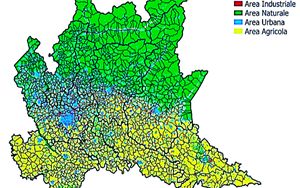(Finance) – A study by Polytechnic of Milan published in the Chemosphere magazine quantified the impact of agricultural land on the spatial distribution of concentration of fine particles (PM2.5) in Lombardy, showing how it is comparable to that of other sources of pollution that are much better known and studied, such as industrial plants, urban areas or the road network. This comparable impact was seen not only for rural areas, but also in more densely populated areas.
In particular, the effect due to agricultural land was found to be correlated with more intense pollution peaks rcompared to what was measured in industrial and urban areas, but with a limited duration in time. Among the individual crops analysed, a negligible impact of rice fields was recorded, while it was more significant for land cultivated with cereals and corn. These results were obtained through an innovative framework and a data-driven model that includes the evaluation of the impact of different land uses on the spatial distribution of PM2.5 concentrations, to analyze the role of agricultural land with a sensitive much greater than pre-existing models.
For this purpose they were analyzed satellite data and atmospheric models of the Copernicus program for the measurement of PM2.5 concentration together with the open access database of land use and the agricultural information system of the Lombardy Region. For the analysis, an innovative GEOAI (Geomatics and Earth Observation Artificial Intelligence) system was used, composed of a three-stage architecture, which allows the capture and interpretation of spatial dynamics at a local level, thus comparing the effects linked to the different use of territory on pollution. Thanks to this new approach, it will be possible in the future to generate evidence regarding pollutant concentrations correlated to non-specific agricultural activities, such as spreading and fertilization.
The work was born in the context of D-DUST (Data-driven modeling of particUlate with Satellite Technology aid) research projectfinanced by Cariplo Foundation, whose aim was to evaluate the contribution – in terms of operability, cost-effectiveness and accuracy – derived from the systematic integration of unconventional data in traditional particulate monitoring approaches based on fixed ground sensors, with particular attention to the satellite-based and agriculture-related emissions estimates.
The project managers are Prof. Maria Brovelli and Eng. Daniele Oxoli, of the Department of Civil and Environmental Engineering of the Polytechnic of Milan, in collaboration with prof. Enrico Caiani and the engineer. Lorenzo Gianquintieri, of the Department of Electronics, Information and Bioengineering of the Polytechnic of Milan, with Dr. Santoni of the Polytechnic Foundation of Milan and with prof. Andrea Spinazzè of the University of Insubria.
